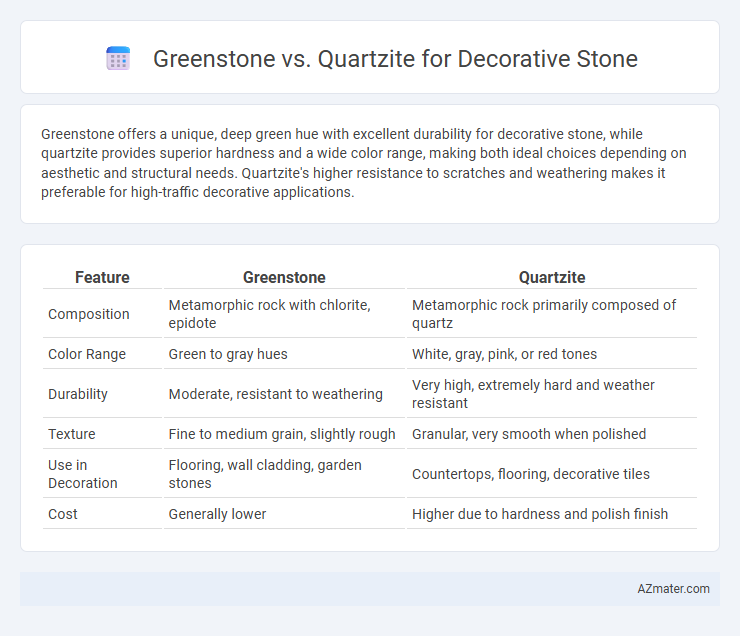Greenstone offers a unique, deep green hue with excellent durability for decorative stone, while quartzite provides superior hardness and a wide color range, making both ideal choices depending on aesthetic and structural needs. Quartzite's higher resistance to scratches and weathering makes it preferable for high-traffic decorative applications.
Table of Comparison
| Feature | Greenstone | Quartzite |
|---|---|---|
| Composition | Metamorphic rock with chlorite, epidote | Metamorphic rock primarily composed of quartz |
| Color Range | Green to gray hues | White, gray, pink, or red tones |
| Durability | Moderate, resistant to weathering | Very high, extremely hard and weather resistant |
| Texture | Fine to medium grain, slightly rough | Granular, very smooth when polished |
| Use in Decoration | Flooring, wall cladding, garden stones | Countertops, flooring, decorative tiles |
| Cost | Generally lower | Higher due to hardness and polish finish |
Introduction to Greenstone and Quartzite
Greenstone is a durable metamorphic rock known for its rich green hues and smooth texture, making it a popular choice for decorative stone in landscaping and interior design. Quartzite, a hard and dense metamorphic rock formed from sandstone, offers exceptional resistance to weathering with its high quartz content, often showcasing a range of white, gray, and subtle pastel colors. Both stones provide unique aesthetic qualities and durability, with greenstone prized for its vibrant color and quartzite valued for its hardness and natural beauty.
Geological Formation and Composition
Greenstone, formed from metamorphosed basaltic lava, is rich in chlorite and epidote, giving it its distinctive green hue and fine-grained texture ideal for decorative stone applications. Quartzite originates from the metamorphism of quartz-rich sandstone, resulting in a hard, dense stone composed predominantly of interlocking quartz crystals, prized for its durability and glassy luster. The geological formation processes influence their mineral composition and color, making greenstone suitable for vibrant, natural green accents, while quartzite offers a more neutral palette with exceptional hardness for long-lasting decorative surfaces.
Aesthetic Appeal and Color Variations
Greenstone offers a rich, deep palette of greens and blues with a smooth to slightly textured surface that enhances its natural elegance for decorative stone applications. Quartzite features a broader spectrum of colors, including whites, grays, pinks, and golds, with a sparkling, crystalline texture providing a dynamic and vibrant aesthetic. The choice between Greenstone and Quartzite depends on desired color intensity and surface finish, with Greenstone emphasizing earthy tones and Quartzite showcasing diverse hues and brilliance.
Durability and Hardness Comparison
Greenstone exhibits moderate hardness typically ranging between 5 to 6 on the Mohs scale, making it sufficiently durable for indoor decorative applications but less resistant to heavy wear and abrasion. Quartzite is significantly harder, rating around 7 on the Mohs scale, offering superior durability, scratch resistance, and suitability for high-traffic areas or exterior use. The inherent hardness of quartzite ensures it withstands impact and weathering far better than greenstone, making it the preferred choice where longevity and resistance to physical stress are critical.
Weather Resistance and Longevity
Greenstone exhibits excellent weather resistance due to its dense structure and mineral composition, making it highly durable in outdoor environments. Quartzite, known for its hardness and resistance to abrasion, also stands up well to weathering but may show slight oxidation or fading over time depending on exposure. Both stones offer impressive longevity, with Greenstone generally providing a more stable color retention while Quartzite excels in resisting structural wear.
Maintenance Requirements
Greenstone requires minimal maintenance due to its natural resistance to staining and weathering, making it ideal for both indoor and outdoor decorative applications. Quartzite, while extremely durable and scratch-resistant, often needs periodic sealing to maintain its aesthetic appeal and prevent staining, particularly in high-traffic areas. Both stones benefit from regular cleaning with mild soap and water to preserve their natural beauty and longevity.
Eco-Friendliness and Sustainability
Greenstone and quartzite both offer eco-friendly options for decorative stone, but greenstone is often favored for its lower carbon footprint due to minimal processing and local sourcing. Quartzite provides durability and natural beauty, yet its extraction and processing can be more energy-intensive, impacting sustainability. Choosing greenstone supports environmental conservation through reduced resource consumption and promotes sustainable building practices.
Common Decorative Applications
Greenstone and quartzite are popular choices for decorative stone due to their durability and aesthetic appeal. Greenstone, known for its rich green hues and smooth texture, is commonly used in countertops, floor tiles, and garden pathways to create a natural, elegant look. Quartzite features a granular, often sparkling surface with neutral tones, making it ideal for wall cladding, fireplace surrounds, and outdoor paving where strength and style are essential.
Cost and Availability Analysis
Greenstone is generally more affordable than quartzite due to its relative abundance and easier extraction process, making it a cost-effective option for decorative stone projects. Quartzite, being a harder and more durable metamorphic rock, commands a higher price and is less readily available, especially in regions without local deposits. Availability of greenstone is higher in areas with volcanic activity, while quartzite is commonly found in mountainous regions, impacting procurement costs and lead times for both materials.
Final Considerations: Choosing the Right Stone
Greenstone offers a unique, earthy aesthetic with durability suitable for indoor and outdoor decorative stone applications, while quartzite provides superior hardness and resistance to abrasion, making it ideal for high-traffic or heavily used surfaces. Consider the environment, maintenance requirements, and desired visual effect, as greenstone's softer mineral composition can weather over time compared to the more resilient quartzite. Budget, installation conditions, and long-term performance are critical factors in selecting between greenstone and quartzite for decorative stone projects.

Infographic: Greenstone vs Quartzite for Decorative Stone
 azmater.com
azmater.com